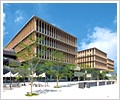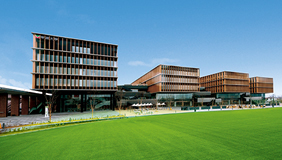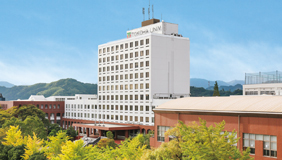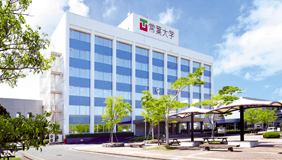Japanese / English
Graduate Degree Program of Disaster and Environment Studies
We offer two-year graduate programs leading to the degree of Master of Environment and Disaster Research. Two courses are offered at the school: (1) Disaster research, and (2) Environment research.
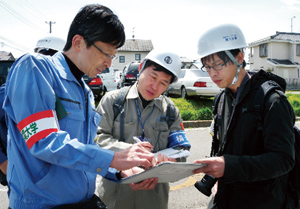
Survey, the Great East Japan Earthquake
(Left: Prof. Satoshi Tanaka)
Disaster Research Course
Graduate students are expected to understand social impacts by disasters. Through our research, we continuously verify aspects of disaster damage in our society as well as understand a process of response, restoration, or reconstruction. It is also essential to consider countermeasures required to improve response capabilities in the community and society. Topics may include issues regarding disaster disciplines, such as administrative and social institutions, promotion of Business Continuity Management, etc. Our research takes a role in realizing a future sustainable society where citizens appropriately prepare, respond, and cope with disasters. It is essential to study in coursework, acquire expertise, and contribute to society.
Graduate students are expected to understand social impacts by disasters. Through our research, we continuously verify aspects of disaster damage in our society as well as understand a process of response, restoration, or reconstruction. It is also essential to consider countermeasures required to improve response capabilities in the community and society. Topics may include issues regarding disaster disciplines, such as administrative and social institutions, promotion of Business Continuity Management, etc. Our research takes a role in realizing a future sustainable society where citizens appropriately prepare, respond, and cope with disasters. It is essential to study in coursework, acquire expertise, and contribute to society.
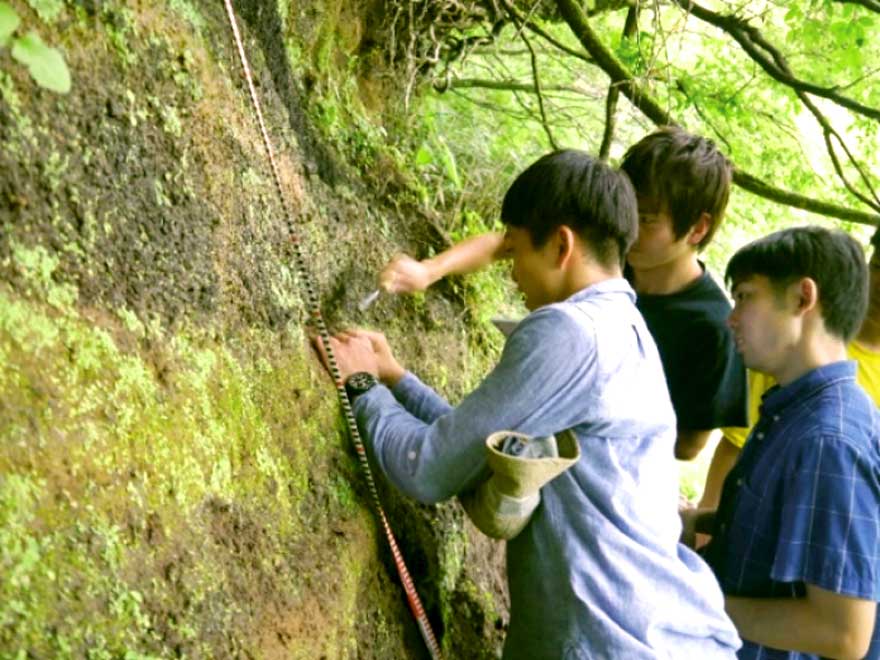
Field studies of volcanic ash layers at the foothills of Mount Fuji
Environment Research Course
The earth system has been maintained by the dynamic balance of the interactions among human society, ecosystem, and natural environment. However, at present, we are facing the irreversible destruction of the earth system caused by the environmental burdens from the expanding anthropogenic activities and the exploitation of natural resources. To address the global crisis of the environment and contribute to the realization of a sustainable society, we are conducting multidisciplinary education and research including academic fields with different scales, such as geoscience, ecological science, environmental chemistry, health science, and molecular biology. In the Environment Research course, graduate students are expected to acquire leading-edge knowledge of the environmental studies and the relevant area in a cross-sectional way by employing the rich natural environment in the Shizuoka area as a subject.
The earth system has been maintained by the dynamic balance of the interactions among human society, ecosystem, and natural environment. However, at present, we are facing the irreversible destruction of the earth system caused by the environmental burdens from the expanding anthropogenic activities and the exploitation of natural resources. To address the global crisis of the environment and contribute to the realization of a sustainable society, we are conducting multidisciplinary education and research including academic fields with different scales, such as geoscience, ecological science, environmental chemistry, health science, and molecular biology. In the Environment Research course, graduate students are expected to acquire leading-edge knowledge of the environmental studies and the relevant area in a cross-sectional way by employing the rich natural environment in the Shizuoka area as a subject.
Curriculum
Subjects for both courses:
Psychology of Environment and Disaster, Anthropology of Environment and Disaster, Geographical Information
Subjects for the Disaster Research Course:
Geology for Disaster Prevention, Information System for Disaster Management, Ethnography in Disaster, Disaster Recovery and
Reconstruction Planning, Urban Risk Management, Education for Disaster Preparedness,
Natural Disaster Science and Engineering, etc.
Subjects for the Environment Research Course:
Environmental Science, Ecological Science, Biological Function, Environmental Physiology, etc.
Dissertation:
Participation in research is emphasized from the first year. All students present their research plan at the beginning of the fall
semester in the first year. In the second year, progress reports and a public hearing on the dissertation are required.
(12 credits for 2 years)
*Minimum credits required for graduation: 30
Psychology of Environment and Disaster, Anthropology of Environment and Disaster, Geographical Information
Subjects for the Disaster Research Course:
Geology for Disaster Prevention, Information System for Disaster Management, Ethnography in Disaster, Disaster Recovery and
Reconstruction Planning, Urban Risk Management, Education for Disaster Preparedness,
Natural Disaster Science and Engineering, etc.
Subjects for the Environment Research Course:
Environmental Science, Ecological Science, Biological Function, Environmental Physiology, etc.
Dissertation:
Participation in research is emphasized from the first year. All students present their research plan at the beginning of the fall
semester in the first year. In the second year, progress reports and a public hearing on the dissertation are required.
(12 credits for 2 years)
*Minimum credits required for graduation: 30
Dissertation Topics
Various dissertation topics have been conducted: global environmental problems, disaster response, and restoration analyses based on fieldwork investigation, developing and implementing computer systems to support disaster victims using spatial information processing, etc. Examples are shown in the box below.
Topics of Disaster Research
Topics of Environment Research
Topics of Disaster Research
- Study about evaluation of improving safety of tsunami evacuation by the utilization of low-unused land on fishery village : The case of Heda area, Numazu city
- A study on the housing reconstruction policy and implementation process after Wenchan earthquake in China
- Development of training programs to cultivate community leaders for disaster management in response
- Role analysis of emergency housing repairing system in housing reconstruction -Case study of Ojiya city in Mid Niigata Prefecture Earthquake -
- Consciousness for disaster reduction in Chinese foreign students in Japan and response in a local community
- Development of planning process and promoting measures of Business Continuity Plan for smaller business enterprises using restricting factor analysis
Topics of Environment Research
- Development of biogas quantitative method using weight method
- Effect of the air micro bubble introduction on the activated sludge treatment
- Analyzing inhabit restricting factors on Tanakia ianceolata and Procodularia japanensis
- Research of vernacular engineering methodology on vernacular property policy in the Abe River basin
Faculty Members
- Disaster Research Course
ABE Ikuo
Research Interests:
Information for disaster management: content and dispatching methods, etc.
Information for disaster management: content and dispatching methods, etc.
Publication:
- 駿河湾内の津波痕跡に着目した1498年の明応東海地震の津波波源の検討(土木学会論文集B2(海岸工学)第73巻)
- 浜松市立伊目小学校における地震津波を想定した避難場所選定に関する検討(常葉大学社会環境学部研究紀要,第4号)
- 地殻変動即時推定と津波浸水予測データベースの併用による高精度津波浸水予測の検討(土木学会論文集B2(海岸工学)第71巻)
- 津波観測情報を利用した津波避難方法の検討 ~大川小学校、女川町の事例分析を通して~(地域安全学会論文集,No.24)
- PROBLEMS AND EFFECTS OF A TSUNAMI INUNDATION FORECAST SYSTEM DURING THE 2011 TOHOKU EARTHQUAKE(Journal of JSCE,Vol.1)
- 東北太平洋沖地震におけるGPS 波浪計を利用したリアルタイム津波浸水予測の検証(土木学会論文集B2(海岸工学))
◆Staff Information Page
IKEDA Hirotaka
Research Interests:
Research on evacuation behavior, Research on the recovery process from disasters, etc.
Research on evacuation behavior, Research on the recovery process from disasters, etc.
Publication:
- Co-author;The village lives beyond the tsunami disasters,KAJIMA INSTITUTE PUBLISHING CO., LTD,2019
- • Optimization of Allocation of Destinations of Evacueesfrom a Tsunami in an Urban Area -A Case Study in Daini-chiku in Numazu City- (PDF ファイル 2.55MB)
- • Development of Teaching Materials to Instruct the Next Genaration from the Experience of Victims of Tsunami Disasters and Community Development for Disaster Mitigation in Tsunami -prone Areas - Case Study of Tahama Settlement in Sanrikuchoryori Ofunato, Iwate - (PDF ファイル 2.3MB)
- • A New Attempt at Designing a Human Resource Training Workshop for Future Generations Supporting Revival of Communities in Disaster Areas (PDF ファイル 0.66MB)
- • Planning Process of Community Revival Plan in Sanrikuchoryori Ofunato, Iwate and Results on Disaster Mitigation Side (PDF ファイル 0.9MB)
- • Multi Agent Simlation Model for Evaluating Evacuation Plan in Urban Area for Protection against Tsunami Disaster (PDF ファイル 1.59MB)
KOUMOTO Hiroko
Research Interests:
Social psychology for environment and disaster management, organizational behaviors in disaster response, life restoration process after disasters
Social psychology for environment and disaster management, organizational behaviors in disaster response, life restoration process after disasters
Publication:
- Observing Affected Households' Life Restoration Processes after a Disaster - Case Study: The Great East Japan Earthquake, 2011- (Institute of Social Safety Science Papers of workshop of the Great East Japan Earthquake,No.9)
- Analysing a Life Restoration Process of a Home evacuee -A Case Analysis of Ishinomaki City after the Great East Japan Earthquake Using Trajectory Equifinality Model- (Japanese Association of Qualitative Psychology The 16th Annual Convention, Poster presentation)
- A Study on Psychological Changes in Life Restoration Process of Disaster Victims (Japanese Association of Qualitative Psychology The 15th Annual Convention, Poster presentation)
- Social Media Activities during Restoration after the Great East Japan Earthquake (Disaster Management and Human Health Risk IV)
- Revising a Regional Disaster Management Plan Using Ethnographic Data (Disaster Management and Human Health Risk III)
- Examining External Assistance in Emergency Response Using Interview Data -Case Study: The Great East Japan Earthquake, 2011- (Journal of Socia Safety Science, No.20)
SHIGEKAWA Kishie
Research Interests:
Systems and countermeasures for increasing disaster response abilities in local communities, volunteers and administrations
Systems and countermeasures for increasing disaster response abilities in local communities, volunteers and administrations
Publication:
- 質的調査に基づく津波犠牲者発生プロセスの分析―宮古市田老地区の事例― (PDF ファイル 0.44MB)
- 福島原発事故による被災者の生活再建過程に関する研究 (PDF ファイル 1.35MB)
- 仙台市シルバー人材センターが生活再建支援活動に果たす役割と今後の課題 (PDF ファイル 0.99MB)
- 借上げ仮設住宅供与に関わる自治体の災害対応過程と課題の分析 (PDF ファイル 0.99MB)
- 市町村合併が災害対応にもたらした影響分析―東日本大震災時の石巻市を事例として― (PDF ファイル 0.37MB)
- すまいの再建支援策相互の連関と課題の分析-新潟県中越地震における小千谷市の事例- (PDF ファイル 0.38MB)
- 新潟県中越地震における建物被害認定調査の現状と課題 (PDF ファイル 0.37MB)
- 借上げ仮設住宅施策を事例とした被災者の住宅再建に関する研究 (PDF ファイル 0.63MB)
SHIMANO Taketo
Research Interests:
Geological mechanisms and phenomena of volcanic eruption, estimation of volcanic hazards
Geological mechanisms and phenomena of volcanic eruption, estimation of volcanic hazards
TANAKA Satoshi
Research Interests:
Earthquake damage in engineering architectures, Disaster victim support systems, Life reconstruction process of disaster victims
Earthquake damage in engineering architectures, Disaster victim support systems, Life reconstruction process of disaster victims
- Environment Research Course
ASAMI Kayo
Research Interests:
Plant ecology and Vegetation science for biodiversity conservation
Plant ecology and Vegetation science for biodiversity conservation
Publication:
- Nakayama, A. and Asami, K.(2020) Mechanism of maintaining cobble-bar vegetation and the geomorphic conditions for existence of refugia during large floods. Journal of Hydro-environment Research 30. 91-99
- Asami, K., Nakayama, A. Kawatani, T. and Fujita, I.(2018) Characteristics of flow and bedform in a river reach with cobble bar vegetation and its refugia. 12th International Symposium on Echohydraulics.
- Asami, K., Nakayama, A. and Kawatani, T.(2016) Hydrodynamic effects and role of river morphology in conservation of cobble bar vegetation.11th International Symposium on Echohydraulics.
- Asami, K., Nakayama, A. Kawatani, T. and Fujita, I.(2015) Hydrodynamic effects on refugia of cobble-bar vegetation established along river bend.36th IAHR World Congress.
- 川谷健・浅見佳世(2014) 河川湾曲部の礫河原におけるカワラハハコ群落のレフュージアの水理特性について.建設工学研究所論文報告集56,1-12.
- Asami, K., Nakayama, A. Kawatani, T. and Fujita, I.(2014) Conditions of flood disturbances and refugia for conservation of cobble-bar vegetation). 10th International Symposium on Echohydraulics.
- 浅見佳世・中山昭彦・川谷健・藤田一郎(2013) 揖保川中流カワラハハコ群落成立地の植生学的および水理学的考察.土木学会論文集B1(水工学)69(4):I_1339-I_1344.
- Asami, K., Akamatsu, H., Fukui, S and Tamura, K.(2012) Morphological characteristics of flood refugia of cobble-bed vegetation (2012) . Journal of Hydro-environment Research 6 (2). 127-136.
IKEDA Masahiko
Research Interests:
Environmental study for human safety and health
Environmental study for human safety and health
Publication:
- Shimba Y., Senda R., Katayama K., Morita A., Ikeda M., Kamei Y., Miura S.: Skeletal muscle-specific forkhead box protein-O1 overexpression suppresses atherosclerosis progression in apolipoprotein. Biochem Biophys Res Comm. 2021, 540, 61-66
- Shimba Y., Katayama K., Miyoshi N., Ikeda M., Morita A., Miura S.: β-aminoisobutyric acid suppresses atherosclerosis in apolipoprotein E-knockout mice. Biol Pharm Bull. 2020, 43, 1016-1019
- Shimba Y., Togawa H., Senoo N., Ikeda M., Miyoshi N., Morita A., Miura S.: Skeletal muscle-specific PGC-1αoverexpression suppresses atherosclerosis in apolipoprotein E-knockout mice. Sci Rep. 2019, 9, 4077
- Saito K., Nagahashi R., Ikeda M., Nakamura Y.: Honeybee (Apis mellifera L, Hymenoptera: Apidae) produce honey from flowers of tea plants (Camellia sinensis L., Theaceae). Am J Exp Agricul. 2016, 10, 1-4
- Wakuda H., Uchida S., Ikeda M., Tabuchi M., Akahoshi Y., Shinozuka K., Yamada S.: Is hyperuricemia a risk factor for atherosclerosis? Uric acid and arteriosclerosis in apolipoprotein E-deficient mice. Biol Pharm Bull. 2014, 37, 1866-1871
- Chiba T., Ikeda M., Umegaki K., Tomita T.: Estrogen-dependent activation of neutral cholesterol ester hydrolase underlying gender difference of atherogenesis in apoE-/- mice. Atherosclerosis. 2011, 219, 545-551
- Sato Y., Ikeda M., Ito T., Tomita T., Yokotani K., Murata M., Umegaki K.: Ascorbic acid levels and neutrophil superoxide production in blood of pre-, early and late hypertensive stroke-prone spontaneously hypertensive rats. Clin. Exp. Hypertens. 2011, 33, 397-403
- Mori K., Kobayashi C., Tomita T., Inatomi S., Ikeda M.: Antiatherosclerotic effect of the edible mushrooms Pleurotus eryngii (Eringi), Grifola frondosa (Maitake), and Hypsizygus marmoreus (Bunashimeji) in apolipoprotein E-deficient mice. Nutrition Res. 2008
- Ikeda M., Suzuki C., Umegaki K., Saito K., Tabuchi M., Tomita T.: Preventive effects of green tea catechins on spontaneous stroke in rats. Med. Sci. Monitor 2006, 13, BR40-45
- Ikeda M., Tamura M., Yamashita J., Suzuki C., Tomita T.: Repeated in utero and lactational 2,3,7,8-tetrachlorodibenzo-p-dioxin exposure affects male gonads in offspring, leading to sex ratio changes in F2 progeny. Toxicol. Appl. Pharmacol. 2005, 206, 351-355
- Ikeda M., Mitsui T., Setani K., Tamura M., Kakeyama K., Sone H., Tohyama C., Tomita T.: In utero and lactational exposure to 2,3,7,8- tetrachlorodibenzo-p-dioxin in rats disrupts brain sexual differentiation. Toxicol. Appl. Pharmacol. 2005, 205, 98-105
KONNO Asaka
Research Interests:
Hydrological and geomorphological studies under semi-arid climate in central Kenya, land use design for surface fault rupture hazard based on quantitative analysis using GIS, vegetation history of subalpine forest inferred from plant opal analysis.
Hydrological and geomorphological studies under semi-arid climate in central Kenya, land use design for surface fault rupture hazard based on quantitative analysis using GIS, vegetation history of subalpine forest inferred from plant opal analysis.
Publication:
- Asaka Konno, Takeya Yoshiki, Yoshihiko Sano. Run-up Height Distribution of the 2011 Tohoku Earthquake Tsunami around the Omoe Peninsula and the Miyako Bay, Northeast Japan Quarterly journal of geography, 63(3), 147 – 152, 2011
- Asaka Konno. Environmental Conditions of Small Stands of Abies mariesii Forest in Pseudo-alpine Zone on Mt. Akita-Komagatake, Northern Japan. Quarterly Journal of Geography, 68(3), 165 – 182, 2016
- Daisuke Ishimura, Shinji Toda, Toshihiko Ichihara, Naoya Takahashi, Asaka Konno, Hayato Sato. A study on surface ruptures around Miyaji, Aso City, Kumamoto Prefecture, associated with the 2016 Kumamoto earthquake sequence and upward slip tapering on pit excavation walls. Active Fault Research 2017(47), 9 – 16, 2017
- Shinji Toda, Masayuki Torii, Mitsuru Okuno, Asaka Konno, Hiroki Ono, Naoya Takahashi. Evidence for Holocene paleoseismic events on the 2016 Kumamoto earthquake rupture zone within the Aso caldera: A trench excavation survey at Kurokawa, the town of Minami-Aso, southwest Japan. Active Fault Research, 2019(51), 13 – 25, 2019
KURODA Masashi
Research Interests:
Environmental microbiology and biotechnology, metal resource recycling using metal-metabolizing bacteria, biodegradation of chemicals, bioenergy production
Environmental microbiology and biotechnology, metal resource recycling using metal-metabolizing bacteria, biodegradation of chemicals, bioenergy production
Publication:
- Kuroda M., Suda S., Sato M., Ayano H., Ohishi Y., Nishikawa H., Soda S., Ike, M. (2019) Biosynthesis of bismuth selenide nanoparticles using chalcogen-metabolizing bacteria. Appl. Microbiol. Biotechnol., 103:8853–8861
- Zhang Y., Kuroda M., Arai S., Kato F., Inoue D., Ike M. (2019) Biological treatment of selenate-containing saline wastewater by activated sludge under oxygen-limiting conditions. Water Res., 154: 327-335
- Zhang Y., Kuroda M., Nakatani Y., Soda S., Ike M. (2018) Removal of selenite from artificial wastewater with high salinity by activated sludge in aerobic sequencing batch reactors. J. Biosci. Bioeng., 127(5):618-624
- Ike M., Soda S., Kuroda M. (2017) Bioprocess approaches for the removal of selenium from industrial waste and wastewater, pp.57-73 In Bioremediation of Selenium Contaminated Wastewater (Ed. Eric van Hullebusch), Springer
- Ike M., Yamashita M., Kuroda M. (2017) Microbial Removal and Recovery of Metals from Wastewater, pp.573-595, In Applied Bioengineering: Innovations and Future Directions (Advanced Biotechnology) (Ed. Toshiomi Yoshida), Wiley-VCH
MITSUI Tetsuo
Research Interests:
Involvement of estrogen-receptors and intercellular interaction in the proliferation regulation mechanism of estrogen-responsive cells, neuroendocrine actions of estrogen and its action mechanism
Involvement of estrogen-receptors and intercellular interaction in the proliferation regulation mechanism of estrogen-responsive cells, neuroendocrine actions of estrogen and its action mechanism
Publication:
- Mitsui T., Ishida M., Izawa M., Arita J. (2017) Activation of G protein-coupled estrogen receptor 1 mimics, but does not mediate, the anti-proliferative action of estradiol on pituitary lactotrophs in primary culture. Endocr J., 64:103-115
- Wang L., Mitsui T., Ishida M., Izawa M., Arita J. (2017) Rasd1 is an estrogen-responsive immediate early gene and modulates expression of late genes in rat anterior pituitary cells. Endocr J., 64:1063-1071
- Mitsui T., Ishida M., Izawa M., Arita J. (2013) Differences between rat strains in the development of PRL-secreting pituitary tumors with long-term estrogen treatment: In vitro insulin-like growth factor-l-induced lactotroph proliferation and gene expression are affected in Wistar-Kyoto rats with low estrogen-susceptibility., Endocr J., 60:1251-1259
- Mitsui T., Ishida M., Izawa M., Kagami Y., Arita J. (2011) Inhibition of Bcl3 gene expression mediates the anti-proliferative action of estrogen in pituitary lactotrophs in primary culture. Mol Cell Endocrinol., 345:68-78
- Mitsui T., Taniguchi N., Kawasaki N., Kagami Y., Arita J. (2011) Fetal exposure to 2,3,7,8-tetrachlorodibenzo-p-dioxin induces expression of the chemokine genes Cxcl4 and Cxcl7 in the perinatal mouse brain. J Appl Toxicol., 31:279-284.
Contact Information
Prof. Hirotaka Ikeda
Dean of Graduate School of Environment and Disaster Research,
Tokoha University
6-1 Yayoi-cho, Suruga-ku, Shizuoka city,
Shizuoka 422-8581, Japan
E-mail: ikeda_h [at] sz.tokoha-u.ac.jp
Dean of Graduate School of Environment and Disaster Research,
Tokoha University
6-1 Yayoi-cho, Suruga-ku, Shizuoka city,
Shizuoka 422-8581, Japan
E-mail: ikeda_h [at] sz.tokoha-u.ac.jp






